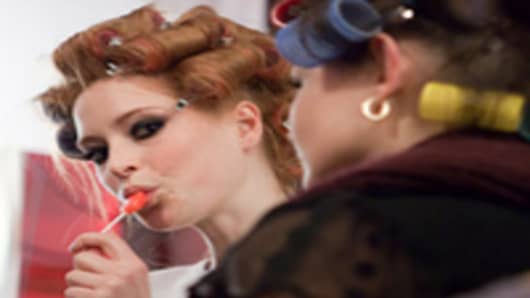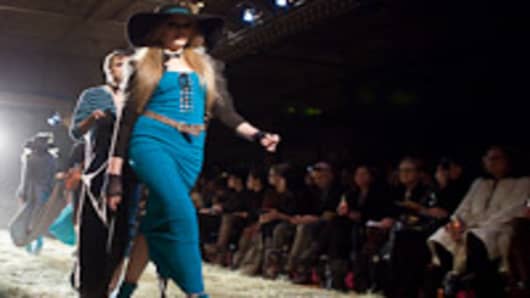Splashes of vibrant colors, metallics, a combination of fabrics and embellished backs have dominated the runway so far at New York Fashion Week, quieting some style experts' criticisms that designers have been playing it safe to appeal to an uncertain consumer.
Glittered leggings and metallic belts paraded down the runway at the Rebecca Taylor show, while an embellished, draped look fluttered down the catwalk at Donna Karan. The always outrageous Betsey Johnson dressed models as bandana-clad bandits for her Kiss Kiss Bang Bang show, and Georges Chakra showed a gold gown, detailed with beaded butterflies on its cut-out back.
Fashion expert Sharon Haver, who runs the Web site focusonstyle.com, said she thinks the season's pieces offer consumers something different than the latest shows, with many also being able to be worn every day. This combination of style and value will likely drive weary consumers to spend on getting the latest looks, she said.
"You can get yourself these big, fabulous coats or jackets and it sort of pulls everything else together," she said. "There is a lot of mixing fabrics. I think that's what gets people excited."
Retailers and analysts had been looking to New York Fashion Week to show bold trends, something they said it failed to produce the past two seasons. That's because designers tend to avoid risk during economic downturns, preferring to stick with simple styles to preserve their margins, said Citigroup analyst Deborah Weinswig.
But as consumer confidence starts to show signs of renewed strength, fashion-savvy shoppers have become bored with basics and muted colors, and are instead looking for edgy styles — a formula that has proven successful for some retailers.
"Innovation is definitely key because we always are looking for the newest thing," said Colleen Sherin, women's fashion director at Sak's Fifth Avenue . "As soon as new merchandise hits the floor people react."
Sherin said that designers' strategies made a subtle shift toward more bold looks in their Spring 2010 collections, when animal prints and detailing started to emerge.
She anticipated the Fall 2010 season would bring more innovation, as the Pre-Fall collections showed ornamentation and embellishments, such as lace and sequins, as well as pops of yellows, blues and greens.
This was especially seen among jewelry, which had been in a phase of minimalism, and shoes, Haver said.
"I see color more as an accent rather than the primary force in your wardrobe," Haver said, calling it a "smarter, more realistic" way to build a wardrobe in a time of reduced spending.
She added that new fabrics, such as velvet, as well as mixing leather with lace, will also allow shoppers to update their looks for less.
Betsey Johnson, known for ignoring trends and always producing vibrant styles, said that instead of playing it safe during tough economic times, she gets even crazier.
"It's the edgy stuff that's selling," she said, citing her bustle coats as one of her top sellers. "There are more people out there ready for it than you think … If you're going to buy something, it has to really mean something to you."
But even if consumers do plan to purchase the styles seen at Fashion Week, it will have to wait until August, when the clothes first hit the stores. This delay, along with the event's tendency to feature outrageous looks designed more to grab media attention than consumers' interest, causes many to argue the runway's relevance.
But although high-end retailers such as Saks, which carry such designers as Herve Leger and Carolina Herrera, are more directly affected by shows than fast-fashion stores such as H&M or Zara, the trickledown effect to traditional retailers is undeniable, experts said. This is increasingly true in the Internet era, as retailers can view snapshots of designers' looks immediately following the show, and then duplicate them. And with big-time names such as Marc Jacobs streaming their shows over the Web this season, it's become even easier to spawn knockoffs.
What's more, because it takes about 17 weeks for lower-priced retailers to evolve their designs from concept to inventory — about one month less than the time it takes for looks to move from the runway to the selling floor at stores such as Saks — they're knocking them off at a faster pace.
This tightens the correlation between the runway and the consumer.
"It is really giving [fast-fashion stores] an opportunity to compete with the much more fashion-forward retailers," Weinswig said.
More from Consumer Nation:
- Why Can't Barbie Keep a Job?
- Consumer Is Not Dead, but Is Creeping Along
- Magazines Push Into Mobile Commerce
- A Look Inside the 2010 Miami International Boat Show
Questions? Comments? Email us at consumernation@cnbc.com




